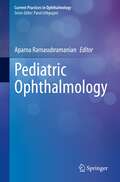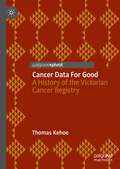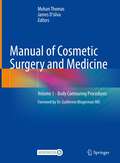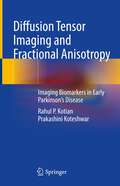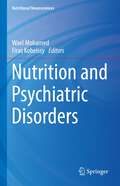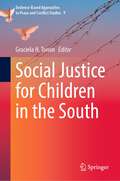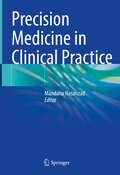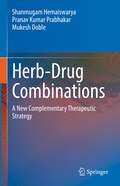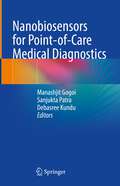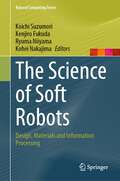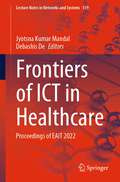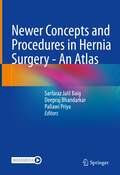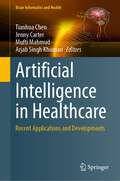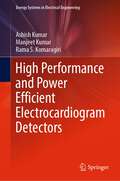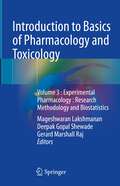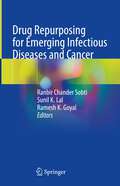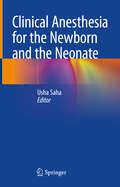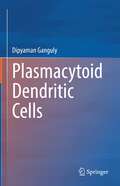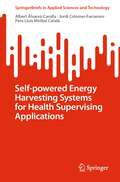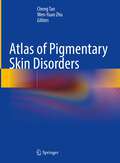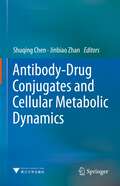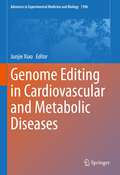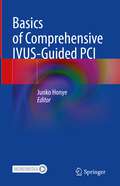- Table View
- List View
Pediatric Ophthalmology (Current Practices in Ophthalmology)
by Aparna RamasubramanianThe book provides a comprehensive review of the current trends in pediatric ophthalmology. It covers well-researched and up-to-date information and keeps the readers updated with the current literature. Pediatric ophthalmology is a vast area with multiple subspecialties and the book helps streamline the literature for rapid reference. The editors and authors are experts in the field. The book is helpful for the general ophthalmologist, ocular oncologist, ophthalmology residents and fellows in training optometrists.
Cancer Data For Good: A History of the Victorian Cancer Registry
by Thomas KehoeThis book examines the history of the Victorian Cancer Registry (VCR) in Australia from its establishment in the late 1930s through to the present day. It sheds new light on the history of medicine and the broader social and cultural histories affected by advances in cancer control science, providing a historical account of cancer registration that is empirically grounded in new archival and oral sources. It addresses the obstacles that proponents of cancer registration faced, how governments came to support permanent registries, and the subsequent contributions of the VCR and other registries to cancer research. In charting this history, the book discusses some of the political, social, and cultural implications of registry-driven science, and the links between developments in scientific knowledge and campaigning for policy changes around cancer.
Manual of Cosmetic Surgery and Medicine: Volume 1 - Body Contouring Procedures
by Mohan Thomas James D’silvaThe most comprehensive cosmetic plastic surgery manual on body contouring surgeries explains in detail how to undertake body contouring procedures to remove excess fat deposits and sagging skin so as to improve the shape as well as the tone of the abdomen, back, thighs and other areas of the body, resulting in a body with smoother contours and providing an appropriate shape. It also describes the latest procedures including high definition and fine definition liposuction with the use of various technologies and body contouring after massive weight loss. It also contains chapters on important procedures of fat grafting along with live stem cells, and how they can only be harvested from the fat during liposuction. This surgical manual discusses all possible body contouring procedures in a step by step “How To” manner so as to help the novice Cosmetic Surgeon’s as well as seasoned and experienced Surgeon’s alike. The risks, complications along with pearls are discussed along with individual procedures with a series of step-by-step photographs and pre and post images and short video clips.This Manual in Cosmetic Surgery and Medicine sets the standard for doctors entering the field of aesthetic surgery and medicine. It is a reference book for people who are in practice as well as a step-by-step manual for students and young doctors wanting to pursue this field.The other volumes are on: • Rhinoplastic procedures• Intimate Genital procedures • Non-Invasive Aesthetic procedures• Breast reshaping• Cosmetic procedures of the Face
Diffusion Tensor Imaging and Fractional Anisotropy: Imaging Biomarkers in Early Parkinson’s Disease
by Rahul P. Kotian Prakashini KoteshwarThe book covers all aspects of one of the most advanced magnetic resonance imaging techniques, namely Diffusion Tensor Imaging (DTI) and Fractional Anisotropy (FA) values in early Parkinson’s disease (PD) patients. It provides step-by-step descriptions of DTI and its use in the early diagnosis of Parkinson’s disease by using FA values at several grey and white matter regions of the brain with helpful MRI DTI images. It includes clear flow charts with MRI DTI imaging protocol for Parkinson’s disease to aid in early diagnosis and treatment. The book covers essential information on anatomy and pathology in Parkinson’s disease and includes dedicated chapters on diffusion tensor imaging and FA in Parkinson’s disease. Additionally, it covers the role of magnetic resonance imaging in Parkinson’s disease with routine findings for Parkinson’s disease in MRI, followed by advanced imaging biomarkers and predictors in Parkinson’s disease. The book will assist the practitioners in the early detection of Parkinson’s disease using specific imaging biomarkers with the help of FA values, which will help in the early treatment of PD patients and thus extend and improve their quality of life. It will also be relevant for MD radiology, M.Sc. medical imaging technology students/trainees and Ph.D. medical imaging graduates as well as B.Sc MIT students.
Nutrition and Psychiatric Disorders (Nutritional Neurosciences)
by Wael Mohamed Firas KobeissyThe book comprehensively reviews the role of nutrition in psychiatric disorders. It provides mechanistic insights into the effects of nutrition on metabolic pathways, mitochondrial nutrients, neurodegeneration and CNS disorders, cell signaling, and neuronal functions. The book further highlights the role of diet in preventing and treating mental health and modifying drug treatment effects. Further, it explores the relationship between nutrition and psychiatric disorders, including depression, autism, anxiety, Attention-Deficit / Hyperactivity Disorder, and OCD. The book further explores the recent advancements in understanding the important role of nutrients as therapeutics in various psychiatric disorders. Lastly, it presents an overview of nutrients as neuroprotective agents along with the main principles of nutrigenomics. The book is essential reading for neuroscientists interested interest in food therapeutic strategies.
Social Justice for Children in the South (Evidence-Based Approaches to Peace and Conflict Studies #9)
by Graciela H. TononThis book considers that contextual factors are important for the achievement of social justice and it recognizes that vulnerability to which children are exposed is a phenomenon throughout the planet, particularly in the South. It presents a theoretical review of social justice as well as different situations of vulnerability children experience in their daily lives in which they can be injured, affecting their well-being and the exercise of their rights. It examines the impact of the COVID-19 pandemic on children, considered as a vulnerable group warranting special social policy considerations. It also presents the need to change power structures in knowledge production and decision-making processes to achieve social justice for children; the importance of investing in children; the exclusion of children from participation in certain activities and the shame of not being able to participate in equal conditions with others; the lives of migrant children belonging to ethnic minorities exposed to language barriers and access to technological devices; and the analysis of the process of social re-integration of children from conditions of armed conflict. The book concludes that governments need to assume social justice as part of universal human interests, providing security, conditions for well-being, and guaranteeing social justice for all children.
Precision Medicine in Clinical Practice
by Mandana HasanzadThe book provides complete information on the cornerstones of precision medicine through the omics approach. Clinical applications of genomics and precision medicine have progressed from a theoretical wish list to an impactful force in medical practice.Step-by-step descriptions are provided from basics to the future application and its benefit in clinical practice. Precision medicine aims to personalize health care by tailoring decisions and treatments to each individual in every possible way. Precision medicine includes pharmacogenomics. Essential information is provided on the role of precision medicine and pharmacogenomics in the clinical practice of cancer, cardiovascular disease, diabetes, psychiatric disease, and also the importance for healthcare professionals. This book will assist the practitioners how to integrate precision medicine and pharmacogenomics data into their clinical practice. It is hoped that physicians, pharmacists, and scientists with basic scientific knowledge of precision medicine will findthis book useful.
Herb-Drug Combinations: A New Complementary Therapeutic Strategy
by Shanmugam Hemaiswarya Pranav Kumar Prabhakar Mukesh DoblePlant extracts or their pure natural constituents have been used traditionally for thousands of years for treating diseases with considerable success in India and other Asian countries. In addition, they have also been used as complements or supplements with conventional medicine. This book discusses the latest research in the application of combination therapy, namely herbs and drugs, in the treatment of a range of communicable and non-communicable diseases to achieve a synergistic effect. This synergy may help in reducing the amount of drug, its toxicity, side effects, and development of resistance as well as improve its efficacy. The book also discusses the pharmacodynamic and pharmacokinetic parameters, experimental tools to determine the impact of combination, computational approaches to identify synergy, statistical analysis of data, and clinical and regulatory issues. The book is useful for researchers in the fields of pharmacology, pharmacy and medicinal chemistry and those working in pharmaceutical and nutraceutical industries. This book could open up new strategies to focus on multiple targets to combat complex diseases unlike the single targeted drugs that are being currently marketed by the pharmaceuticals industries.
Nanobiosensors for point-of-care medical diagnostics
by Manashjit Gogoi Sanjukta Patra Debasree KunduThis book examines the role of nanobiosensors in point-of-care applications for personalized healthcare and management. It begins by discussing various biomaterials that are used for the development of biosensors in medical diagnostics, and reviews advances in their fabrication and the miniaturization of biosensor devices for lab-on-chip analysis. In turn, it explores the rapidly evolving applications of nanomaterials in the context of biomaterial diagnostics. The book also explores the immense potential of biosensors in medical diagnostics, where they are increasingly being used to detect a wide range of biomolecules and biomarkers. In closing, it discusses the current challenges and outlines the future role of nanobiosensors in the development of next-generation point-of-care applications.
The Science of Soft Robots: Design, Materials and Information Processing (Natural Computing Series)
by Koichi Suzumori Kenjiro Fukuda Ryuma Niiyama Kohei NakajimaThe goal of this textbook is to equip readers with as structured knowledge of soft robotics as possible. Seeking to overcome the limitations of conventional robots by making them more flexible, gentle and adaptable, soft robotics has become one of the most active fields over the last decade. Soft robotics is also highly interdisciplinary, bringing together robotics, computer science, material science, biology, etc. After the introduction, the content is divided into three parts: Design of Soft Robots; Soft Materials; and Autonomous Soft Robots. Part I addresses soft mechanisms, biological mechanisms, and soft manipulation & locomotion. In Part II, the basics of polymer, biological materials, flexible & stretchable sensors, and soft actuators are discussed from a materials science standpoint. In turn, Part III focuses on modeling & control of continuum bodies, material intelligence, and information processing using soft body dynamics. In addition, the latest research results and cutting-edge research are highlighted throughout the book. Written by a team of researchers from highly diverse fields, the work offers a valuable textbook or technical guide for all students, engineers and researchers who are interested in soft robotics.
Frontiers of ICT in Healthcare: Proceedings of EAIT 2022 (Lecture Notes in Networks and Systems #519)
by Jyotsna Kumar Mandal Debashis DeThe book includes original unpublished contributions presented at the Seventh International Conference on Emerging Applications of Information Technology (EAIT 2022), organized by Computer Society of India, Kolkata, Chapter during March 30–31, 2022. The book covers the topics such as image processing for smart healthcare applications, computer vision and pattern recognition for health care, Internet of Health Things, 5G and beyond in smart health care for sustainable cities.
Newer Concepts and Procedures in Hernia Surgery - An Atlas
by Sarfaraz Jalil Baig Deepraj Bhandarkar Pallawi PriyaThe atlas focuses on the surgical steps of the latest hernia surgeries elucidated by labeled pictures. It aims to explain the technical aspects of hernia procedures. It includes images that are both graphic and intraoperative clinical photographs for better understanding. The book is written by international experts who have invented and pioneered the newer hernia procedures. Hernia surgery has evolved at a tremendous pace in the last decade. In the last decade, there has been a proliferation of more than 20 procedures in hernia repair, and they offer advantages compared to the older procedures in various clinical situations. Presently, the resources, including images of the newer procedures, are limited to the published journals. This book aims to fill this gap by providing technique based knowledge in an illustrated manner for learning newer hernia procedures. It is written in a succinct style. The book serves as a ready reference for practicing surgeons, minimal access surgeons and, resident surgeons, fellows.
Artificial Intelligence in Healthcare: Recent Applications and Developments (Brain Informatics and Health)
by Tianhua Chen Jenny Carter Mufti Mahmud Arjab Singh KhumanRecent advances in artificial intelligence (AI) and machine learning have witnessed many successes in various disciplines including the healthcare sector. Innovations in intelligent medical systems have revolutionized the way in which healthcare services are provided, ranging from making clinical diagnosis, developing personalized treatment and drugs, assisting patient monitoring, to automating administrative tasks and reducing operational costs. In this book, the authors present key applications in the general area of health care, where AI has made significant successes. From the individual chapters, the readers will be provided with a range of examples to illustrate the wide plethora of application domains utilizing state-of-the-art AI techniques, proving credence to the versatility and effectiveness of an AI approach in health care and medicine. We envisage that this book is ideal for individuals new to the notion of AI in health care, equally, early career academics who wish to further expand on their knowledge in AI in medicine. What will be presented is in no means an exhaustive list of applications, but most definitely a varied one.
High Performance and Power Efficient Electrocardiogram Detectors (Energy Systems in Electrical Engineering)
by Ashish Kumar Manjeet Kumar Rama S. KomaragiriThis book details the characteristics of an ECG signal through the functionality and electrical activity of the human heart. This book provides a basic introduction and needs for developing implantable cardiac pacemaker systems. This book provides comprehensive details on ECG signal processing techniques that are useful for fast and accurate diagnosis of cardiovascular diseases. The book discusses the characteristics and parameters of a typical ECG signal and various noises that can corrupt an ECG signal. It also covers various challenges involved in different stages of signal acquisition, preprocessing, and detection of an ECG signal. The book also presents a detailed survey of various ECG signal detection and data compression techniques. The book contains detailed information on ECG signals and various noises that corrupt an ECG signal. It also includes de-noising techniques, ECG peak detection techniques, and ECG data compression techniques. It also includes step-by-step details to design various filters in MATLAB. This book, through detailed explanations, provides the reader with necessary information on ECG signal, ECG signal acquisition process, noise removal techniques, and the detection of ECG peaks.
Introduction to Basics of Pharmacology and Toxicology: Volume 3 : Experimental Pharmacology : Research Methodology and Biostatistics
by Gerard Marshall Raj Mageshwaran Lakshmanan Deepak Gopal ShewadeThis volume is designed to impart the fundamental concepts in experimental pharmacology, research methodology and biostatistics. Through this book, the readers will learn about different methods involved in drug discovery, experimental animals and their care, equipments and the various bioassays used in experimental pharmacology. This book contains special sections on various drug screening methods involved in the evaluation of different body systems. Certain sections provide the healthcare professionals with the knowledge necessary to interpret clinical research articles, design clinical studies, and learn essential concepts in biostatistics in an expedient and concise manner. Basic principles and applications of simple analytical methods employed in drug analysis are well written under one section. It focuses on the basic and advanced laboratory techniques and also on computer simulated data, written extensively under the Biostatistics section. The methods used for drug analysis have been described in adequate detail with cross-references for further studies and comprehension. Overall, the book is designed systematically with four broad sections with extensive subdivisions for easy tracking, interpretation, and understanding.
Drug Repurposing for Emerging Infectious Diseases and Cancer
by Ranbir Chander Sobti Sunil K. Lal Ramesh K. GoyalThis book presents drug repurposing strategies to combat infectious diseases and cancer. It discusses key experimental and in silico approaches for modern drug repositioning, including signature matching, molecular docking, genome-wide associated studies, and network-based approaches aided by artificial intelligence. Further, the book presents various computational and experimental strategies for better understanding disease mechanisms and identify repurposed drug candidates for personalized pharmacotherapy. It also explores the databases for drug repositioning, summarizes the approaches taken for drug repositioning, and highlights and compares their characteristics and challenges. Towards the end, the book discusses challenges and limitations encountered in computational drug repositioning.
Urban Forestry and Arboriculture in Malaysia: An Interdisciplinary Research Perspective
by Sreetheran Maruthaveeran Wendy Y. Chen Justin MorgenrothThis book represents the latest research on urban forestry in a Malaysian context. It demonstrates that urban forestry is concerned not only with environmental enhancement, but also other aspects, such as recreation, health and well-being, and government policies. This edited collection provides a comprehensive overview of urban forestry studies from various researchers in Malaysia, and includes rich historical perspectives of urban forestry in the country. It also tackles related issues in policy. The greening of urban Malaysia in the 1970s focused primarily on beautification and was primarily the province of horticulturists, landscapers, nursery workers, town planners, and architects, with negligible inputs from foresters, particularly urban foresters. Perhaps for that reason, the term “landscaping” has been used more widely than “urban forestry” by government and private institutions, politicians, stakeholders, academicians, and the public. Nevertheless, the authors show that the concept of urban forestry is not new for developing countries such as Malaysia, where urbanization is increasing at a rapid rate. The book unpacks this demographic shift from a predominantly rural to a principally urban society. As the only unified body of work on urban forestry and arboricultural studies in Malaysia, this volume presents an important interdisciplinary reference for students, researchers, and scholars in physical geography, forestry and urban forestry, arboriculture and landscape architecture, both in Malaysia, and in other developing urbanizing countries, particularly in Southeast Asia. It is also an important resource for those working in environmental policy and practice, excavating the vital connection between the environment and well-being.
Clinical Anesthesia for the Newborn and the Neonate
by Usha SahaThe book covers all aspects of anesthesia in newborns, neonates (under 28 days) and premature babies. These patients are highly vulnerable, very small in size and weight, at very high risk, and have high mortality and morbidity, which gets further aggravated by the medical diseases and congenital abnormalities these babies may suffer from. The book provides knowledge that equips the anesthetists with the regional techniques used to provide both anesthesia and analgesia, including information about the drugs used, skills in providing neuraxial blocks, nerve blocks, etc., complications thereof and the specially designed equipment for these patients (IV cannula, endotracheal tubes, ryles tubes, laryngoscopes, SpO2 probes, monitors, incubators, warmers and heaters, mattresses, OT tables). The book covers the pharmacology of drugs used, the effect of anesthetic drugs on the developing brain, pulmonary physiology, airway assessment and management, ventilation modes, getting IV and arterial access, preoperative workup, anesthetic management, and postoperative care. It includes care and concerns from both surgical and anesthesia aspects. It covers all the common surgical diseases along with some rare cases such as oncological concerns, palliative care, ethical concerns and pain management. The book also discusses the role and use of ultrasound. The chapter on anesthesia for short procedures includes common birth and neonatal care injuries. The book contains chapters on fluid therapy, blood and blood product transfusion guidelines and indications, resuscitation of a newborn and neonate, and neonatal rehabilitation to improve neonatal outcomes. It contains a dedicated chapter on why these babies are at a high risk of morbidity and mortality and contributing maternal factors. All the chapters are written by experts in their fields with vast experience. This book bridges the gap in the knowledge of an anesthesiologist between anesthesia for children and adults and newborns, neonates and preterm babies.
Plasmacytoid Dendritic Cells
by Dipyaman GangulyThis book provides a systematic review of the development, function, and patho-physiologic role of plasmacytoid dendritic cells (pDCs) in humans. The chapters of the book discuss the origin and discovery, hematopoietic development as well as molecular regulation of pDCs in the context of immune activation as well as immune tolerance. It also discusses the role of pDCs in human diseases, including infections, autoimmune/inflammatory diseases, cancers and metabolic disorders, and opportunities for pDC‐targeting therapies in these varied clinical contexts.
Medicinal Plants: Their Response to Abiotic Stress
by Azamal Husen Muhammad IqbalThis book provides a comprehensive overview of medicinal plants and their interaction with abiotic stress in terms of morphological, physiological, biochemical, and molecular variations, and explains the adaptation and tolerance mechanisms involved. It presents various mechanisms that become operative in medicinal plants to combat stressful situations. The book discusses the secondary metabolites and/or bioactive compounds produced in medicinal plants under abiotic stress conditions, and the use of biostimulants and/or phytoprotectants to alleviate the adverse effects of abiotic stresses on medicinal plants. Additionally, it is likely to address opportunities and challenges in molecular and omics studies of medicinal plants under abiotic stress conditions. Overall, the chapters are developed by eminent subject experts with due care and clarity and cover an up-to-date literature review with relevant illustrations. The book would cater to the need of graduate and post-graduate students, researchers as well as scientists, and may attract the attention of pharmaceutical companies/industrialists and health policymakers.
Self-powered Energy Harvesting Systems for Health Supervising Applications (SpringerBriefs in Applied Sciences and Technology)
by Albert Álvarez-Carulla Jordi Colomer-Farrarons Pere Lluís Miribel CatalàThis book highlights the current and recent state-of-the-art developments in energy harvesting systems for health supervising applications. It explores the exciting potential of energy harvesting as a crosscutting field of research to intersect with other areas to envisage new products, solutions, and applications. Among all these new opportunities for synergy, there is a research area that fully matches the features offered by energy harvesting with its power supply's main needs- health supervising (HS), which consists of monitoring the health or operating conditions of anything, such as structures, buildings, public health, environment, etc. The book covers the hand in hand evolution towards a new paradigm: truly self-powered devices based on a single transducer acting as a sensor and as power source simultaneously and efficiently. This evolution is illustrated by the concept and implementation of novel state-of-the-art architecture for self-powered energy harvesting systems for applications that range from structural health monitoring to point-of-care medical devices.
Atlas of Pigmentary Skin Disorders
by Cheng Tan Wen-Yuan ZhuThis atlas is written to provide readers with the clinical and pathological presentation of the broad spectrum of pigmentary skin disorders (PSD). This book is divided into six parts and covers diseases of hypopigmentation, disorders of hyperpigmentation, hyperpigmentation coexisting with hypopigmentation, pigmentary disorders of the hair, nails, and mucous membranes, and neoplasms with dyschromatosis encountered in clinical practice. Written by experts with rich experience in the field, it will be an invaluable reference not only for dermatologists, cosmetologists, and geneticists but also for anyone interested in the exciting area of PSDs.
Antibody-Drug Conjugates and Cellular Metabolic Dynamics
by Shuqing Chen Jinbiao ZhanThis book summarizes the related research achievements in Antibody-drug conjugates (ADCs) and their cell metabolism kinetics. The book has three main parts. The first part describes the basic theory of ADCs, including the basic concept and structure of ADCs, and the relationship between the targets of ADCs and their specific functions. The second part mainly introduces the endocytosis and intracellular metabolism of ADCs, including the relationship between endocytosis and ADC activity, the endocytosis and intracellular transport of ADCs, the distribution and metabolism of ADC in vivo. Then it discusses the new formats and research technology of ADCs, including the application of miniaturized antibodies in ADC synthesis, novel carriers for ADC design, the technology and application of site-specific conjugation, and approaches for analyzing the drug: antibody ratio (DAR), the study of pharmacokinetics of ADCs. This book combines the basic theory with the research technology. It can be used as a reference book for students, teachers and researchers of biomedical field.
Genome Editing in Cardiovascular and Metabolic Diseases (Advances in Experimental Medicine and Biology #1396)
by Junjie XiaoThis book provides the latest research progress on genome editing in cardiovascular and metabolic diseases and includes bioinformatics research methodology of genome editing. Genome editing is a genetic engineering technique precisely modified specific target genes of organism genome, which has been applied to basic theoretical research and production applications from plants and animals to gene therapy of human beings. Cardiovascular and metabolic diseases have become major factors affecting human health worldwide. This book contains information about bioinformatics, genome editing in cardiovascular diseases, genome editing in metabolic diseases and therapeutic effects. It will be useful for biologist, cardiologist, cardiovascular surgeons, endocrinologist, internists, nurses, undergraduate and graduate students in medicine and cell biology and others interested in cardiovascular and metabolic medicine.
Basics of Comprehensive IVUS-Guided PCI
by Junko HonyeThis practical guidebook describes all aspects of the Intravascular Ultrasound (IVUS) for percutaneous coronary intervention (PCI), sharing many tips & tricks for the basic to advanced use of the technology in daily clinical practice. Chapters describe in detail how to interpret several IVUS findings to apply for PCI strategies, help readers understand the pathogenesis in different cases, as well as the mechanisms of PCI. Practical approaches to performing effective PCI will be discussed with case presentations. Chapters outline many practical topics such as reviewing the IVUS images demonstrating plaque characteristics. Also, a hot topic in stentless PCI, and a special section on the relationship between IVUS measurements and physiological assessments including fractional flow reserve (FFR). Basics of Comprehensive IVUS-Guided PCI is a book to be read by PCI operators, interventional fellows, and staff such as radiology technicians, clinical engineering technicians, and nurses in catheterization laboratories. It also attracts engineers and sales representatives working at medical companies who are curious about IVUS-guided PCI. The authors are experts of IVUS-guided PCI and they will broaden the understanding of the technology to entry level to intermediate operators.
